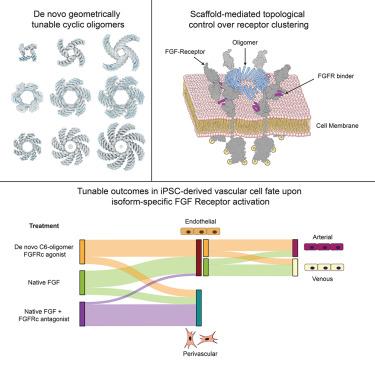Cell ( IF 45.5 ) Pub Date : 2024-06-10 , DOI: 10.1016/j.cell.2024.05.025 Natasha I. Edman , Ashish Phal , Rachel L. Redler , Thomas Schlichthaerle , Sanjay R. Srivatsan , Devon Duron Ehnes , Ali Etemadi , Seong J. An , Andrew Favor , Zhe Li , Florian Praetorius , Max Gordon , Thomas Vincent , Silvia Marchiano , Leslie Blakely , Chuwei Lin , Wei Yang , Brian Coventry , Derrick R. Hicks , Longxing Cao , Neville Bethel , Piper Heine , Analisa Murray , Stacey Gerben , Lauren Carter , Marcos Miranda , Babak Negahdari , Sangwon Lee , Cole Trapnell , Ying Zheng , Charles E. Murry , Devin K. Schweppe , Benjamin S. Freedman , Lance Stewart , Damian C. Ekiert , Joseph Schlessinger , Jay Shendure , Gira Bhabha , Hannele Ruohola-Baker , David Baker

|
Many growth factors and cytokines signal by binding to the extracellular domains of their receptors and driving association and transphosphorylation of the receptor intracellular tyrosine kinase domains, initiating downstream signaling cascades. To enable systematic exploration of how receptor valency and geometry affect signaling outcomes, we designed cyclic homo-oligomers with up to 8 subunits using repeat protein building blocks that can be modularly extended. By incorporating a de novo-designed fibroblast growth factor receptor (FGFR)-binding module into these scaffolds, we generated a series of synthetic signaling ligands that exhibit potent valency- and geometry-dependent Ca2+ release and mitogen-activated protein kinase (MAPK) pathway activation. The high specificity of the designed agonists reveals distinct roles for two FGFR splice variants in driving arterial endothelium and perivascular cell fates during early vascular development. Our designed modular assemblies should be broadly useful for unraveling the complexities of signaling in key developmental transitions and for developing future therapeutic applications.
中文翻译:

使用设计的寡聚组件调节 FGF 通路信号传导和血管分化
许多生长因子和细胞因子通过与其受体的胞外结构域结合并驱动受体胞内酪氨酸激酶结构域的关联和转磷酸化来发出信号,从而启动下游信号传导级联。为了系统地探索受体效价和几何形状如何影响信号转导结果,我们使用可模块化扩展的重复蛋白质构建块设计了多达 8 个亚基的环状同源寡聚物。通过将重新设计的成纤维细胞生长因子受体 (FGFR) 结合模块整合到这些支架中,我们生成了一系列合成信号配体,这些配体表现出有效的价态和几何依赖性 Ca 2+ 释放和丝裂原-激活蛋白激酶(MAPK)途径激活。所设计的激动剂的高特异性揭示了两种 FGFR 剪接变体在早期血管发育过程中驱动动脉内皮和血管周围细胞命运的独特作用。我们设计的模块化组件应该广泛用于揭示关键发育转变中信号传导的复杂性以及开发未来的治疗应用。











































 京公网安备 11010802027423号
京公网安备 11010802027423号